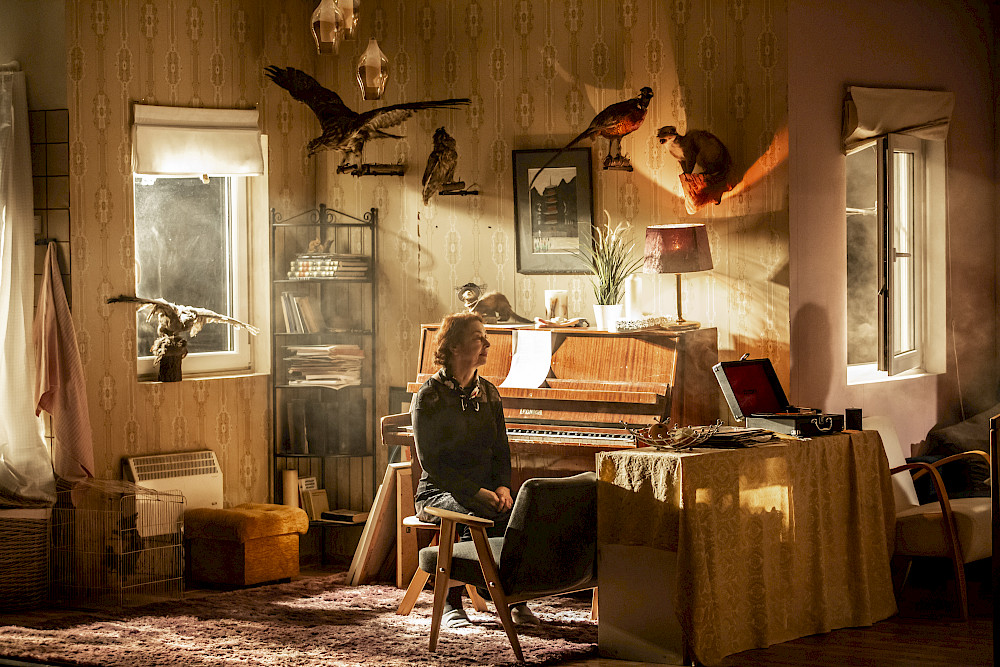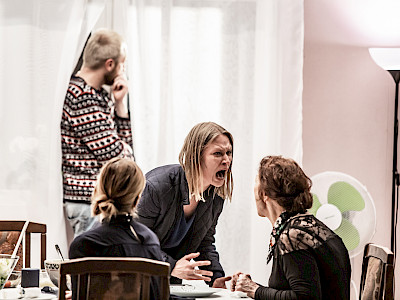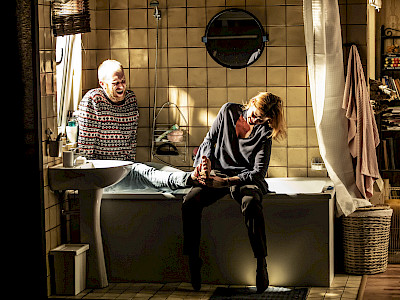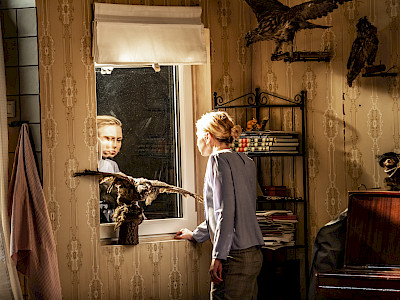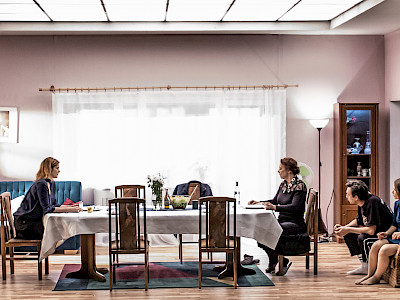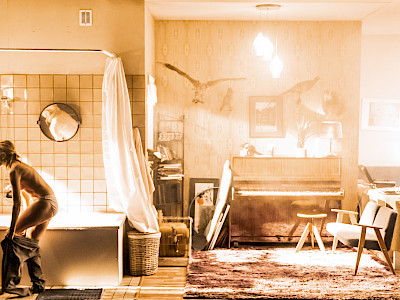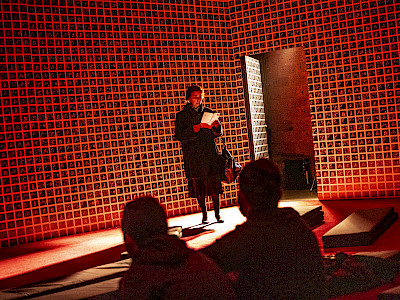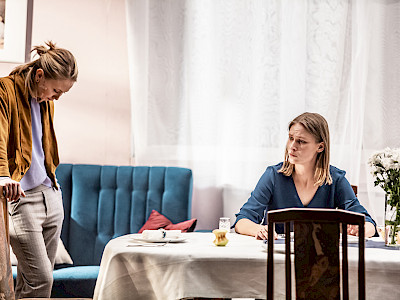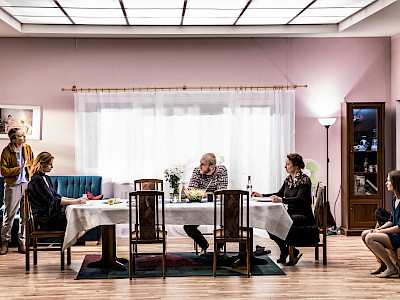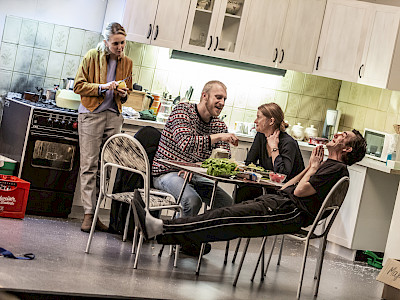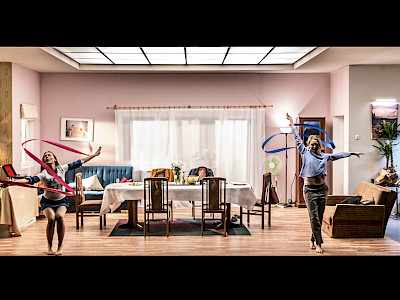10.05, 11.05.2021
Kornél Mundruczó & Kata Wéber / TR Warszawa Warsaw / Budapest
Pieces of a woman
theatre
Polish → FR, NL, EN | ⧖ 2h20 | €10 / €5 | TW: Infant death
How do we deal with peer pressure and the accompanying social judgement about how we should express private emotions? In Pieces of a Woman we follow Maja who, after a traumatic event, feels the consequences and the pressure of her environment as to how she should express and process this event. Is serenity a sin? Can we resist guilt feelings? Kata Wéber has written a trenchant, instinctive text. Together with theatre-maker Kornél Mundruczó, she welcomes us into a family home inhabited by an exceptional group of Polish actors who perform this text with naturalistic precision. The Hungarian artists use their film expertise to create a two-part show. The live film in the first part is contrasted with a second part which, despite the classical theatrical narrative and greater physical distance, gets uncomfortably close. Pieces of a Woman resonates most relevantly with contemporary Polish and Hungarian society, and the role of women’s movement. It is a liberation story: an emancipation from the imposed norms on how to process a traumatic experience; a gradual liberation from compulsory and predefined women’s roles. Little by little we explore Maja’s story and that of her mother’s house, where the story is set.
Czastki Kobiety – Pieces of a Woman
Interview with Kornél Mundruczó
Pieces of a Woman tackles a subject rarely seen in theatre: the birth and loss of a child.
Pieces of a Woman is about the grieving process. The play is divided into two acts, the first of which includes a birthing scene. Because the subject seems so foreign to theatre as a genre, I spent a lot of time thinking about how to show a birth in a believable and watchable way on a theatre stage. We all experience birth, as children or parents. It’s an experience we all share but whose traumatic repercussions have remained rather taboo. I asked myself if that kind of scene didn’t go beyond theatre itself. The emotional experience for the actors and for the audience is real. To circumvent some of those questions, we chose to go with film for the first act, which allows the audience to see the events subjectively rather than as voyeurs. There’s a temporal and dramaturgic arc between the two moments of the play, since the second act is about the trauma caused by the death of the child. That second scene takes place in a traditional theatre setting: the dining room of a family house. The second part explores intergenerational relationships and observes how the members of a family can be affected by the ripples of a tragedy striking one of them. We focus particularly on the character of Maja, a young mother, in her struggle to f ind her own way to grieve, against her family’s conventions and morals, against society’s taboos. Those questions play out in a very simple way, during what looks like any other family dinner, and unfold through moments of sharing, through simple gestures and almost imperceptible details. This appearance of normalcy is the most difficult part to create, it’s what allows us to relate to the characters, to reach a certain perception of the real.
Although this is a universal subject, it’s only recently that we’ve been “allowed” to talk about it. Are you drawn to themes and to an aesthetic which, in its hyperrealism, are reminiscent of cinema?
To create the dramaturgy of Pieces of a Woman, we went through several workshops in order to better understand the characters of the play. We created family trees for instance, dug into their psychology, in particular in relationship with that of the actors, or visited maternity wards and talked with doctors and nurses. Author Kata Wéber was with us throughout, so as to be able to write the play according to what we discovered during this process. But the question of realism in theatre is a particularly difficult one since, according to the conventions of theatre, we’re not dealing with reality in a documentary way, although the actions depicted are very real. We can’t aim for cinematic “realism” either. What I look for in theatre is a way to humanise it as much as possible, by guiding the actors towards a style of performance as true to themselves as possible, as close to their own truth or that of their character. The hyperrealist aesthetic of the setting is simply a way to support this goal. It’s a fundamental quest for the actor to try to be entirely him- or herself, present, while also being completely his or her character. Since I work in both f ields, I can say that cinema and theatre are complete opposites. It’s possible to have a style close to that of cinema, with hyperrealist settings and performances, but the so-called cinematic approach to theatre seems to me problematic and not as interesting. I’d rather talk of a poetic style, in the sense that the relationship to time is as disconnected from reality as it is from the temporality of a film. For instance, we shot the birthing scene of the first act in a single, 27-minute take, which would be unwatchable in a film and unthinkable in reality. This first act is shot from the perspective of the baby as Maja is giving birth to him, in her own apartment, so as to create an immersive situation and create a stark contrast with the second act, which takes places in Maja’s mother’s apartment. I believe in the importance of telling stories, which may be how my approach could be called cinematic. I’m always looking for new stories to unveil. That’s why I think it’s important to work with a contemporary writer, which is the same thing the ancient Greeks did. But what we’re showing and saying here is more poetic than realistic. The setting is as true to life as possible, we paid very close attention to the details, it becomes a sort of meta-story. Each object on the stage tells its own chronology and opens a door onto invisible historical times. Maja’s story takes place in a very precise setting, and that’s what gives the audience the freedom to imagine, interpret, and identify with the events of the play. There are as many points of view as there are characters, which gives the audience a lot of options to understand the play, intellectually or emotionally, so as not to force any particular message or interpretation upon them.
You mentioned the taboo that is the loss of a child…
Those are topics that remain invisible in our societies, especially in Eastern Europe. About 26% of women have experienced the loss of a child aged 4 or younger. This is far from being an exception, but it remains taboo. That’s why the subject is provocative enough in and of itself, there’s no need to toy too much with form and style. Another very important taboo is how traumas are passed on from one generation to the next, which has been proven by scientific research in the field of genetics. The 20th century was so full of tragedy that we all carry within ourselves the potential traces of a genetic trauma, be it due to war or to an authoritarian political regime. How are those stories assimilated, how are the scars they leave passed on from one generation to the next? Our problems and traumas sometimes find their roots in the lives of our parents or grandparents… In the play, Maja has to stand against the point of view of every member of her family regarding the proper way to grieve. When she decides to go against conventions, she becomes a real heroine. There are two levels of reading: the crisis within the family and the social traditions which suppress those traumas. There is also, in a more indirect way, a third story, an invisible story which is a reflection of our society: the story of the midwife Eva, who makes a mistake when trying to save Maja as she’s giving birth to her child. She’s morally innocent, her only goal was to help her, but before the law we are all guilty, or so it goes in Franz Kafka’s world at least. That’s how the play becomes a magnifying glass trained on human relationships. The family is very litigious, they all advise Maja to sue the midwife to get revenge and get some money out of this tragedy. That says a lot about our society and its individualistic streak. The play is about the possibility of communicating in such a divided society. Can we still talk about fundamental subjects at the dinner table? Can we talk within a family to heal traumas? The play never becomes sarcastic or ironic, quite the contrary: it’s built like a succession of character portraits, without judging their actions. In a way, what’s provocative about the play isn’t its form, but its subjects. Maja is the strongest figure in the sense that she manages to break free from the conventions her family’s trying to impose on her, she rebels against what’s “expected” of her. But they’re all both heroes and antiheroes, sometimes brave and generous, sometimes judgmental know-it-alls.
- Interview conducted by Moïra Dalant the 13th February 2020 and translated by Gaël Schmidt-Cléach
Credits for the performance:
Direction: Kornél Mundruczó | Text, adaptation: Kata Wéber | Assistant playwright: Soma Boronkay | Set design, costumes: Monika Pormale | Music: Asher Goldschmidt | Lighting director: Paulina Góral | Assistant director: Karolina Gębska | Stage manager: Katarzyna Gawryś-Rodriguez | Cameraman: Łukasz Jara | Room operator: Łukasz Winkowski | Simultaneous, written translation: Dr Patrycja Paszt | Text translation: Jolanta Jarmołowicz | Set designer assistant, production manager: Karolina Pająk | Costume designer assistant: Małgorzata Nowakowska | Cast: Dobromir Dymecki, Monika Frajczyk, Magdalena Kuta, Sebastian Pawlak, Marta Ścisłowicz, Justyna Wasilewska, Agnieszka Żulewska | Production: TR Warszawa | Performances in Brussels in cooperation with: The Polish Institute-Cultural Service of the Embassy of the Republic of Poland in Brussels
Credits for the recording:
Streaming director, director of Photography: Michał Dymek | Cameramen: Jarosław Dąbrowski, Adam Pietkiewicz, Janusz Szymański, Andrzej Woźniakiewicz | DOP act I: Kornél Mundruczó | Sound engineers: Miłosz Pawłowski, Jakub Sapka | Boom operator: Łukasz Winkowski | Production manager: Maria Herbich | Technical coordinator: Marcin Metelski | Script assistant: Olga Papacz | English subtitles: Artur Zapałowski | French subtitles: Cécile Bocianowski | The recording of the performance is a part of the TR Online programme | Head of production: Małgorzata Cichulska | Production: TR Warszawa | Partner of the performance: Magyar Kulturális Intézet Varsó | Screenings in Brussels in cooperation with: Polish Institute-Cultural Service of the Embassy of the Republic of Poland in Brussels
